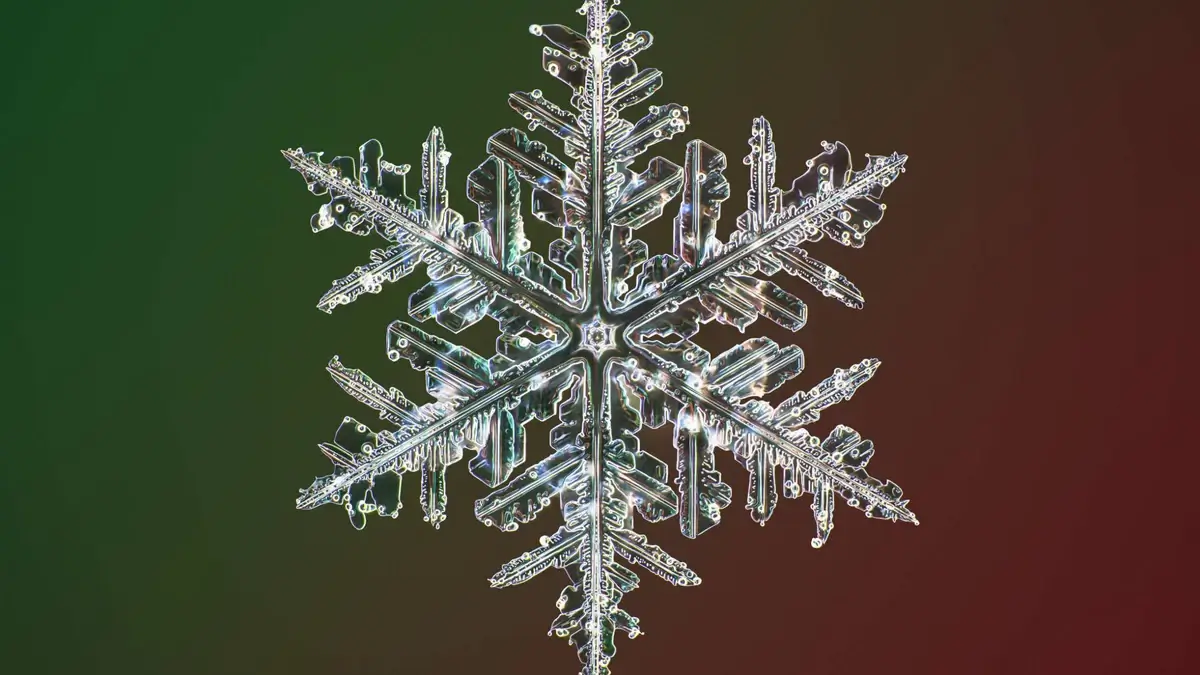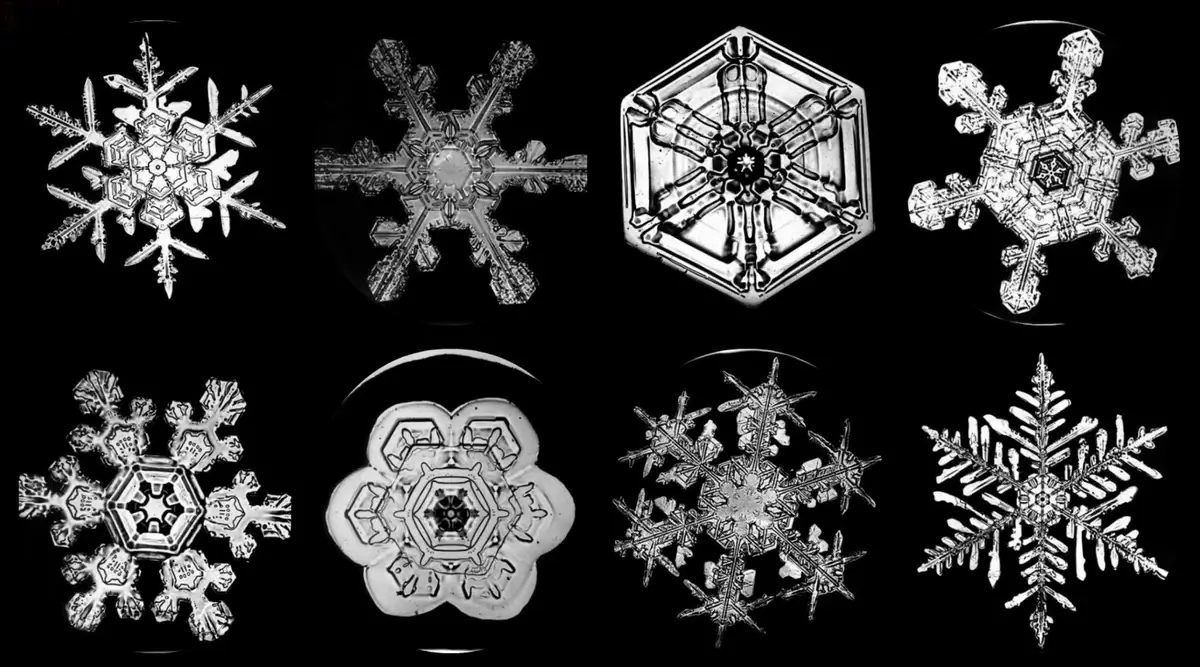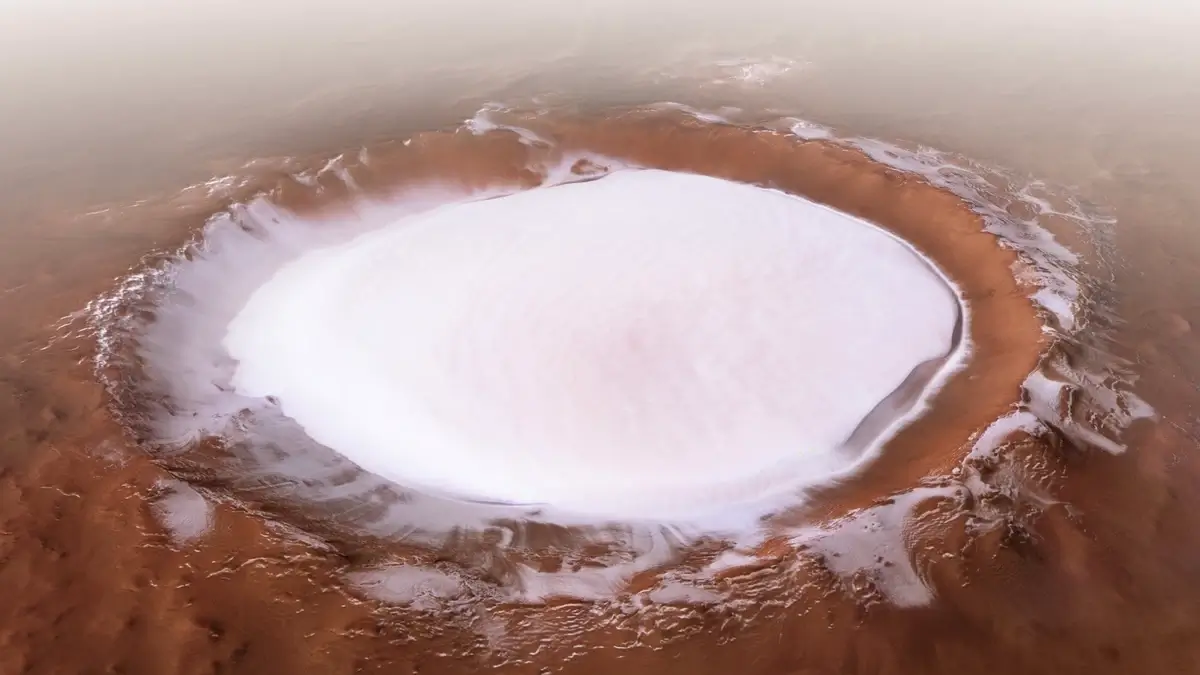Snowflakes, far more than winter’s fleeting decorations, hold a world of scientific wonder. The largest snowflake ever recorded, an astonishing 15 inches across, fell in Fort Keogh, Montana, in 1887, defying common perceptions of snowflake size. These ice crystals can also display a spectrum of colors, including blue and pink, under specific light conditions.
Delving deeper into these and other surprising details reveals a trove of fun facts about snowflakes, each shedding light on the intricate and beautiful world of these tiny ice crystals.
1. Unique Patterns of Each Snowflake: A Myth and Science View
Each snowflake is a unique phenomenon. This diversity stems from their formation in varied atmospheric conditions, leading to nearly infinite designs. Renowned physicist Kenneth Libbrecht highlights that while it’s theoretically possible for two snowflakes to be identical, the probability is extremely low due to the complex environmental variables they encounter during formation.
This uniqueness is a physical manifestation of atmospheric diversity, making each snowflake a distinct piece of natural art.
2. Snowflake Formation: From Vapor to Intricate Beauty
Snowflakes start as water vapor, which freezes into ice crystals at high altitudes. This transformation, known as deposition, bypasses the liquid phase entirely. As they descend, they pass through various layers of humidity and temperature, each influencing their final shape.
This process results in a range of patterns, from simple hexagonal prisms to complex, branching dendrites, highlighting the delicate interplay of environmental conditions in their formation.
3. Snowflake Symmetry: Nature’s Precision in Ice Crystals
The symmetry of snowflakes, each with six arms, is a result of the molecular structure of water. As snowflakes form, water molecules align in a hexagonal lattice, creating a symmetrical pattern. However, micro-variations in temperature and humidity during their fall can result in subtle differences between the arms.
This balance of symmetry and variation is a direct reflection of the intricate laws of physics and chemistry in action.
4. Largest Snowflakes Ever Recorded: Historical Sizes
The record for the largest snowflakes, measuring 15 inches in diameter, was set in 1887 in Fort Keogh, Montana. These giant snowflakes are formed in unique atmospheric conditions, specifically near-freezing temperatures and high humidity, which allow individual snowflakes to stick together, creating larger clusters.
This record challenges our typical understanding of snowflake size and demonstrates the diverse potential of snowflake formation under varying climatic conditions.
5. Snowflake Colors: Unraveling the White Illusion
Contrary to popular belief, snowflakes can exhibit colors other than white. The white appearance is due to the way light scatters off the complex structure of the snowflake. However, in certain conditions, like near sunrise or sunset, snowflakes can reflect different hues, resulting in colored light such as pink, orange, or even blue.
This phenomenon is similar to the way we see colors in the sky during these times. The presence of pollutants can also impact snowflake color, with urban snowflakes occasionally showing a grayish hue due to trapped particles.

Image: mavink.com
6. Diverse Snowflake Types: A Gallery of Crystal Shapes
Snowflakes come in a stunning variety of shapes, categorized into types such as needles, columns, plates, and dendrites. The shape is determined by the temperature and humidity at which the crystal forms. For instance, at temperatures near -2°C, thin plate-like crystals are common, while at -5°C, slender columns are more likely to form.
These types offer a glimpse into the conditions present in the clouds at the time of their formation and underscore the diversity found in these ice crystals.

Image: rsscience.com
7. Temperature’s Effect on Snowflakes: Shape Variations
The shape of a snowflake is significantly influenced by the temperature it encounters during formation. Different temperatures result in different growth patterns of the ice crystals. For example, at -15°C, snowflakes tend to form flat, plate-like shapes, while at -30°C, they grow as long, thin columns.
This variation is due to the way water molecules attach to the ice crystal at different temperatures, resulting in the diverse array of snowflake shapes we observe.
8. Snowflakes in Ecosystems: Beyond Winter Aesthetics
Snowflakes play a crucial role in ecosystems, particularly in regulating temperature and moisture levels. A blanket of snow acts as an insulator, protecting the ground and root systems from extreme cold. Snowflakes also contribute to the world’s freshwater supply as they melt, feeding rivers and reservoirs.
This essential role underscores the importance of snowflakes in maintaining ecological balance, beyond their aesthetic appeal in winter landscapes.
9. Cultural Symbolism of Snowflakes: Global Interpretations
Snowflakes hold significant cultural symbolism around the world. In many cultures, they represent purity and individuality due to their unique and intricate designs.
In Japan, snowflakes are often associated with fleeting beauty, reflecting the transient nature of life. In Western cultures, snowflakes are synonymous with winter holidays and festivity.
This diverse cultural symbolism highlights the snowflake’s role not just as a natural phenomenon, but as a symbol with varied interpretations across different societies.

Oleksandr P / Pexels
10. Preserving Snowflakes Scientifically: Capturing Fragile Art
Scientifically preserving snowflakes is a remarkable feat. Using specialized techniques, researchers can capture and maintain the intricate beauty of snowflakes. One method involves rapidly cooling a microscope slide to preserve the snowflake’s structure before it melts.
This preservation allows for detailed study and photography, helping scientists understand more about snowflake formation and structure. The process highlights the ephemeral nature of snowflakes and the delicate balance required to capture their fleeting beauty.
11. The Acoustics of Snow: Understanding Silent Flurries
The sound, or rather the lack of it, associated with falling snowflakes is a fascinating acoustic phenomenon. Snow acts as a natural sound absorber due to its porous structure, muffling the usual noises of the environment. This effect is most noticeable during heavy snowfall, creating a unique, serene quietness.
Acoustic studies on snow help in understanding how it can influence sound propagation, with applications ranging from urban planning to soundproofing.

Image: nadezhda.kz
12. Snowflakes and Climate Studies: Tiny Climate Indicators
Snowflakes play a critical role in climate studies. They act as tiny indicators of climatic conditions. By analyzing snowflake structures and patterns, scientists can infer atmospheric conditions at the time of their formation. This data is crucial in understanding historical climate patterns and predicting future climatic changes.
Snowflakes, therefore, are not just winter wonders but vital tools in the ongoing study of our planet’s changing climate.
13. The Journey of a Snowflake: Falling Speed
The descent of a snowflake is a gentle journey, falling at an average speed of about three to four miles per hour. This slow and graceful fall contributes to the serene and tranquil atmosphere typically associated with snowfall.
Understanding the speed and movement of snowflakes provides insight into their impact on winter landscapes, creating a peaceful and almost magical scene as they make their way to the ground.
14. Pollen as a Component in Snowflake Formation
Snowflakes forming around pollen particles in the air is a lesser-known yet fascinating aspect of their creation. Traditionally, we think of snowflakes forming around dust particles, but the presence of pollen can also serve as a nucleus for snowflake formation. This process is particularly relevant in regions where pollen is present in the air even during colder months.
Understanding the role of pollen in snowflake formation adds a new layer to our comprehension of these intricate ice crystals and their natural development.
15. Extraterrestrial Snowflakes: The Cosmic Snow Phenomenon
The phenomenon of snowflakes extends beyond Earth, occurring on other celestial bodies. Scientists have discovered snow-like precipitation on planets like Mars and moons such as Saturn’s Titan, although composed of different materials like carbon dioxide and methane.
These extraterrestrial snowflakes offer insights into the atmospheric conditions of other planets and moons, broadening our understanding of weather patterns in our solar system.

The Korolev Crater, situated in Mars’ northern lowlands and spanning an impressive 51 miles, is filled with a significant amount of ice. This image was created by combining multiple shots taken by the Mars Express spacecraft during its orbit around the planet in April. Image: npr.org
FAQ
What color is a snowflake?
Snowflakes are not actually white; they are translucent or clear. Their white appearance comes from the light scattering off the intricate structure of the snowflake. Light is reflected, refracted, and diffused by the complex facets of the ice crystals, which gives snowflakes their white appearance when viewed collectively.
Can 2 snowflakes be the same?
It is extremely unlikely for two snowflakes to be exactly the same due to the virtually infinite number of environmental variables affecting their formation. Each snowflake undergoes a unique journey through differing temperatures and humidity levels in the atmosphere, leading to a unique structure. However, in controlled laboratory conditions, scientists have been able to create snowflakes with identical patterns.
Why is snowflake so beautiful?
The beauty of snowflakes can be attributed to their geometric patterns and symmetrical shapes, which are visually appealing. This symmetry and intricate design are results of the molecular structure of water and the way ice crystals form and grow under different atmospheric conditions. The aesthetic appeal of snowflakes is further enhanced by their uniqueness and delicacy.
What snowflakes symbolize?
Snowflakes commonly symbolize purity and individuality due to their unique and intricate designs. In various cultures, they also represent transformation and the beauty of nature. In some contexts, snowflakes can symbolize serenity and calmness, given the quiet environment they often create when falling.
How cold is a snowflake?
A snowflake forms and exists below the freezing point of water, which is 0 degrees Celsius (32 degrees Fahrenheit). However, the exact temperature can vary depending on the conditions in which the snowflake forms and falls. In different atmospheric conditions, the temperature can range from just below freezing to well below -30 degrees Celsius (-22 degrees Fahrenheit).
What are the 3 main types of snowflakes?
While there are many types of snowflakes, three common types include:
- Stellar Dendrites: These are perhaps the most recognizable snowflakes, characterized by their star-like shape with intricate, tree-like branches.
- Needles: As the name suggests, these snowflakes are thin and needle-like, and they typically form at around -5 degrees Celsius (23 degrees Fahrenheit).
- Plates: These are flat and hexagonal, and they usually form at temperatures closer to the freezing point.





